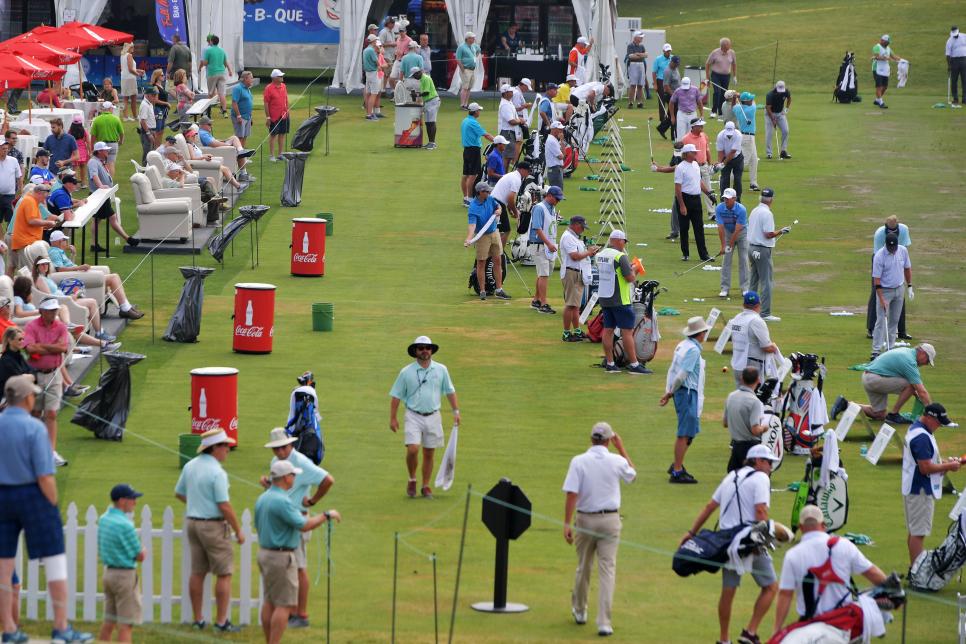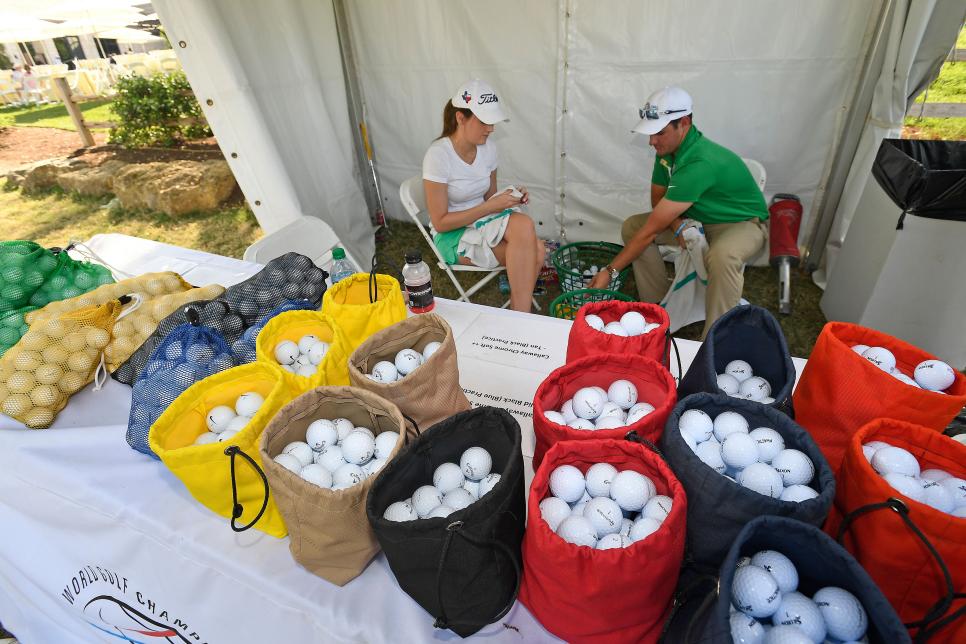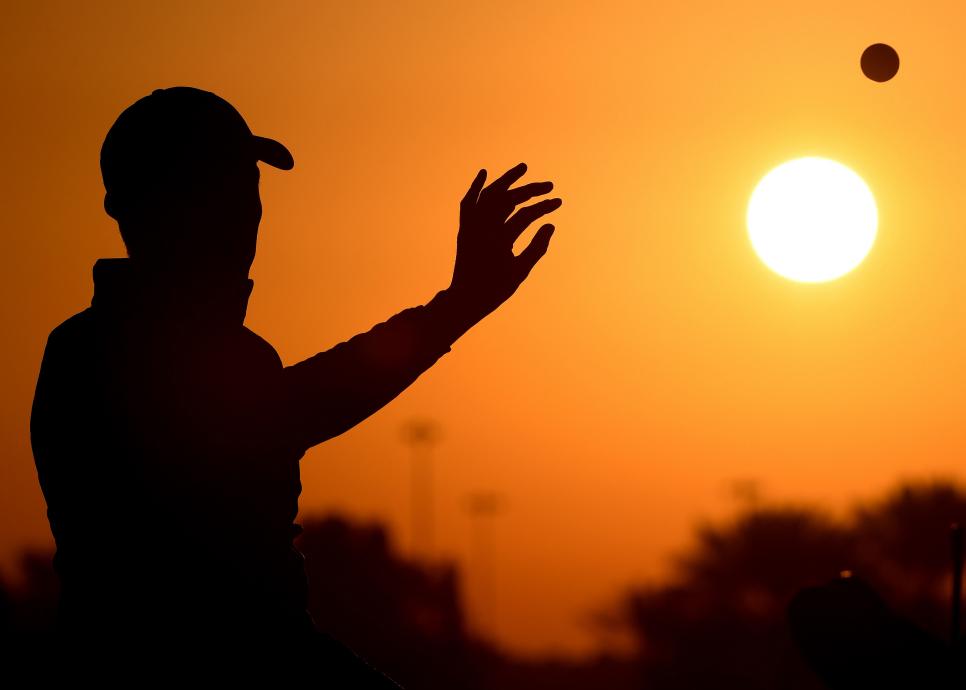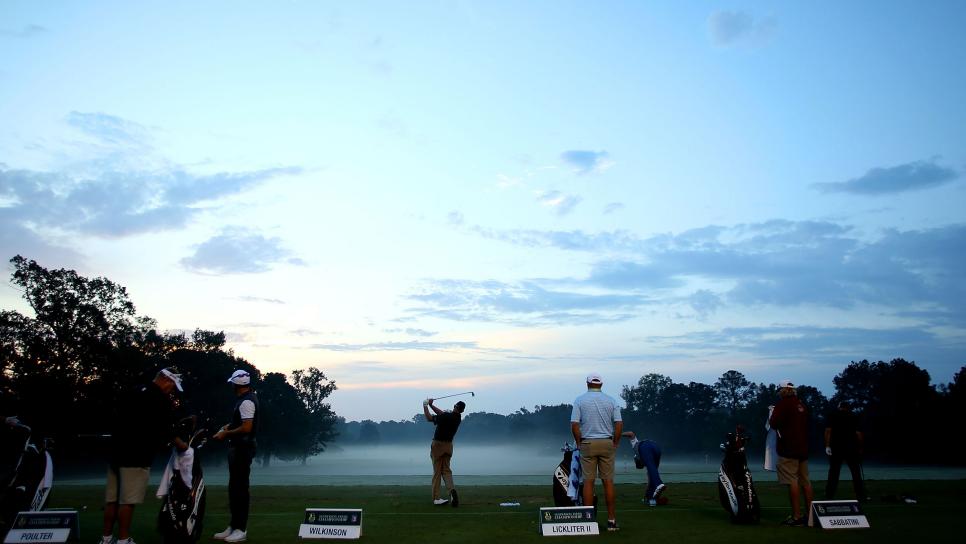Tour Life
The unwritten rules of the PGA Tour driving range

EDITORS' NOTE—This story first was published in 2019. While plenty has happened in men's pro golf since then—the COVID-19 pandemic for starters not to mention the launch of the LIV Golf series (several players quoted have since joined the upstart circuit)—the sentiments of tour pros regarding their time on the practice range hasn't changed substantially, making this read as relevant today as it was when it was first posted.
At first glance, every player looks great on the practice range at a PGA Tour event. Soaring tee shots. SMACK! Piercing irons. THWACK! Look a little closer, though, and you can tell a lot about a guy—his star power, personality, social skills, habits, the state of his game or even his life. It’s not all that dissimilar to high-school hallways all across America. Rickie Fowler? Mr. Popularity. Tiger Woods? The alpha male, though he seems to have softened a bit in recent years. Brooks Koepka? The uber jock.
“There’s this beautiful rhythm,” says Paul Casey. “The players, usual caddies, the press, the reps, the staff. It all flows. Everybody’s aware of who’s working, who’s grinding, who needs to be pampered, who needs to be left alone.”
Bryson DeChambeau and Hideki Matsuyama? They fall into the latter, each endlessly toiling away under the watchful eyes of an army of swing people, video people, equipment people, caddie people, agent people. In the case of DeChambeau, a dew person, too, as you might have heard about the guy spraying mist on each of his practice balls one afternoon at last year’s Tour Championship so the scientist could account for the effects of the droplets on every shot.
Beyond the business of improving their games, there are business transactions being conducted, too, with the range serving as Main Street within the larger neighborhood of tournament golf. Over here is an equipment rep peddling some new magic elixir, over there a swing coach eyeing a potential client. Elsewhere, the media lurking for a hot story.
“This is our office,” says Brandt Snedeker. “We’re trying to get work done out here.”
How each guy goes about doing so can be revealing as well, for there are few formal policies for this office. The rules are unwritten ones, tenets everyone who steps foot on the range understands or quickly absorbs so that the office can run efficiently.

Quinn Rooney/Getty Images
Casey, for example, qualifies as a talker. “He’ll spend an hour-and-a-half here and hit 10 minutes of golf balls,” says veteran caddie Mark Fulcher, who until recently worked for the past 10 years with Justin Rose.
Or as the British say, faffing. Which is why Casey’s caddie, John McLaren, texts his boss a minute-by-minute itinerary that includes the precise time to arrive at the range, putting green and tee box, each day, also accounting for the time it takes to walk from one to the other.
“Once I start, I won’t talk to anybody,” Casey says.
He’s not the only one.
“People know if I’m quiet to leave me alone,” says Jason Day. “If I’m talking, I’m more relaxed and don’t mind it. But if I’m trying to concentrate, I’ll go to a quieter spot. Or, sometimes there are some guys you just don’t get along with or don’t click with or don’t talk to.”
Whatever the case, players are largely creatures of habit. Casey’s routine includes a down-the-line string in the ground to work on his path, and a 50-ball warm-up that’s supposed to take 26 minutes, from lob wedge through driver. The divot pattern is precise, though it’s far less artful than the carefully crafted checkerboard masterpieces PGA Tour Champions player Tom Pernice is known for carving, or the perfectly straight, long trenches Vijay Singh has been digging for decades.
There are a few who break the mold, however. The quick-talking, jittery Snedeker, for example. “I’m all over the place,” he says, pointing to a pattern that is akin to something you’d see at your local muny. “I’m always moving around and changing targets. I move within three feet up and back and around. I’ve always been that way. I’m too scatterbrained. I’m always trying different things, trying to find the next fix.”

Stan Badz/PGA Tour
Then there’s the matter of where some players set up shop. Usually it is not accidental. Some prefer the right side of the range because being there often promotes a cut, according to a handful of players. Some go left for the opposite reason, a draw. The wind also plays a factor—into the wind lets a player know immediately how he’s hitting it, because any mis-hit will get exposed by the breeze.
“I used to go to the right end of the range because when I take the club back, my biggest fault is I take it back a little inside, and being on the right side would make me take it back more square,” Snedeker says. “But you’ll see guys even set up certain ways based on the position of the sun because they don’t like to see their swing in their shadow.”
Hovering near all those shadows are other operators, from caddies who sometimes double as bodyguards, to equipment reps hawking their wares, to the 10-percenters signing all those lucrative deals, down to the practice-range staff charged with keeping the place running.
Ever since the first year of the Wells Fargo Championship, in 2003, Todd Lawton has been the man overseeing a brigade of volunteers—mostly golf-program students or club pros—who help keep things orderly amid the organized chaos at Quail Hollow. With a field of 156 and 5,000-plus balls a day of up to a dozen brands, it’s no small task.

Chris Condon/PGA Tour
On Wednesday of pro-am day this year, the first of his crew arrived at 5:20 a.m. The first ball in the air on the range came 35 minutes later. This, after Kyle Stanley was the last man to close down the joint the night before, the last of the volunteers not done filling in divots until after 8:30 p.m.
“It’s funny, guys won’t hit each others’ balls, even if it’s the same type,” Lawton notes. “If there’s a bag with some leftovers, they’ll toss it out of the way and grab their own from here.”
Lawton, an affable club pro and the golf coach at the University of South Carolina-Upstate the past 14 years and Queens University in Charlotte before that, has seen it all, from the maniacal, to the absurd, to the humorous.
One time, DeChambeau’s coach snagged five bags of balls, carefully inspecting each pellet and tossing aside ones he deemed unfit. “It was about two bags' worth,” Lawton said, laughing. “We’re looking at [the balls] like What’s wrong with them? Whatever works.”
On another occasion, a local TV reporter dressed in a tiger costume popped out from behind a tent and attempted to give the real Tiger a hug. Then there was the Dennis Walters clinic with 150 kids. The wheelchair trick-shot artist, inducted into the World Golf Hall of Fame last week, proceeded to hit one so high that 35 kids sprinted onto the range trying to catch it, with other pros still hitting nearby. Kids are fearless, and resourceful. Most of them returned with their pockets stretched full of golf balls.
Lawton didn’t need security to procure them, although law enforcement is around if needed. But with Tiger not in the Wells Fargo field, only one or two police officers were regularly on duty at the range, as is the case most weeks.

Ross Kinnaird
More omnipresent are the equipment staff, responding to texts or calls from their players to bend a wedge here, tweak a driver there. The changes are rather simple but precise.
“It used to be way worse,” says TaylorMade VP of Global Tour Operations Keith Sbarbaro, who has been a fixture on ranges for two decades. “Bob Estes and Steve Flesch were big-time tinkerers. Now, no one is really an annoying tinkerer. Fitting is way easier with TrackMan and all the adjustables on clubs. In the old days, if a guy wanted a club to turn over more, you’d have to build him a new driver. Now, we change the weights or the lofts, and that pretty much solves it.”
That’s not the only difference. Twenty years ago, the range was like the Wild West. All it took for someone slinging equipment to get a credential that provided access to the range was a fee. Now, at least one player has to already be using your stuff to get one. The economics of the equipment market have changed the process as well. In the more financially fertile days of driver wars, companies were notorious for spending $10,000 for a guy to use their stick that week to gain an advantage in driver count on tour, a key marketing tool they could use for consumers. With the business less ephemeral than what it was a decade ago, along with the advent of social media, that’s no longer the case. The result is a more professional scene with relationships that are far more convivial—gone are the days when a rep from one company would leave a box of prototype balls in a player’s locker, only to have a rival rep come in a few minutes later and remove them.
“It’s night and day from when I first came out,” Sbarbaro says. “Seventy-five percent of the tour could play any woods it wanted. There were no contracts. It used to be a complete sales hustle job. Now it’s pretty casual.”

Marianna Massey
Then there are the ranges themselves.
For a while, 27-year-old Smylie Kaufman forgot what it was like to be on the PGA Tour after losing his card, suffering through injury and being relegated to the Web.com Tour, where the ranges are a little different. There were a lot less people, for one, and a lot more problems, for another.
“Some ranges [on the Web] just aren’t good,” he said. “I just care about the dirt. Are you able to get enough club on it where you can get some height on your shots?”
Having a level, manicured surface to hit from helps. So does space, for not all ranges even on the PGA Tour are created equally. Among those courses with some of the best that players see all year: Augusta National, TPC Sawgrass, Quail Hollow, TPC River Highlands.
A great course or event, meanwhile, doesn’t necessarily equal a great range. Riviera, Torrey Pines, Waialae and Kapalua are considered some of the weakest practice facilities on tour because of their constricting confines or bad target lines. (Or, in some cases, nets!)
“It creates a little bit of havoc,” Snedeker says. “You’re always looking for a guy hitting drivers because you know they’re almost done. On pro-am days, you want to find a guy who’s not playing and might nudge your way in for 30 minutes.”
That’s not all they have to worry about.
“You’ll get the occasional ‘Tin Cup’ shank down the range,” Snedeker says.
As the week goes on, the dynamic changes, too. “What you find is that on Monday, Tuesday, Wednesday, everyone’s optimistic,” Fulcher says. “It doesn't matter if you're playing well or missed five cuts in a row. It’s a new week, a fresh start.”
After that is when things start to get quieter, more serious. The hangers-on are gone and the social element fades as the tournament unfolds. “It’s a big change from a Tuesday and Wednesday to a Thursday,” Rose says. “You’ll see some guys stressing and some guys panicking.”
Rose’s favorite time there? It’s the same as everyone else’s.
“Sunday,” he says, smiling. “When you’re one of the last two guys on the range.”

